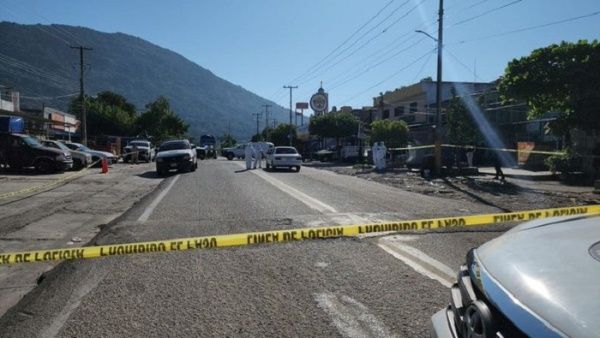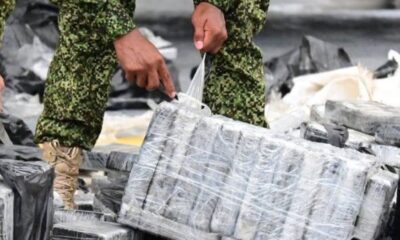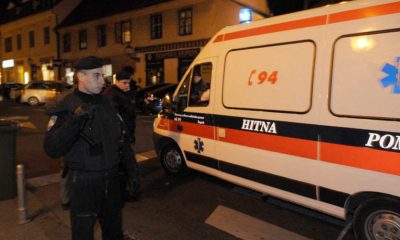International
The boarding school that fights for the future of seven indigenous peoples in the Amazon of Peru

Shirts, pants and backpacks hang from wooden beams in a large room full of old bunk beds in which students from a particular educational center sleep in the heart of the Amazon of Peru. This residence and institute welcomes 248 adolescents of seven ethnic groups who seek to improve their future and, with it, that of their peoples.
The Yankuam Jintia high school (‘Luz en el camino’, in the indigenous language Achuar) is located in San Lorenzo, capital of the Datem del Marañón, and is an option for teenagers who do not have educational centers in their small indigenous communities.
It has teenagers from 12 to 18 years old of the shawi, condoshi, wampis, quechua, awajún, shapra and achuar ethnic groups, from 95 peoples, so the mixture of languages and cultures is breathed in the walls full of murals.
It houses realities of all kinds, from adolescents whose families have decided to give a better education for their children than their community can provide, to those who are orphans or have suffered abuse and did not have a safe home.
“We are always doing shifts so that they are not alone. We are always here with you at all times, they are small who come for the first year at 11 and 12 years old. They are very brave when leaving the family to come to study (…) They need the paternal warmth from us as mother and dad,” the director of the center, Sandra Elizabeth Flores, tells EFE.
He explains to EFE in the courtyard that this place was born as a male boarding school at the initiative of the missionaries of the Sacred Heart of Jesus, who saw 50 years ago the little access that young people in these areas had to education.
“It was seen that our young people didn’t adapt much. There was a little bit of discrimination, because they didn’t master Spanish. Then the students came sad,” says the director, adding that for this reason the boarding school also became an intercultural school that respected the various origins of adolescents.
She adds, proudly, that the center has also been open since 2016 for girls, who are now a little more than half of the total.
“We do a comprehensive job trying to ensure that the children are respected, that the original language is maintained and we are working with a culture of peace,” says Flores.
The residence has an area for girls and a boys’ area, with several rooms per age group, in which some students have their books, hygiene material and glossy shoes tidy, while others keep their muddy slippers next to their toothbrushes.
“The reality in this educational institution, on the one hand, is fun, we share cultures, beliefs, experiences with each other and we make the union as a family, but we lack some basic needs since the institution does not have enough resources,” Jean, a 15-year-old young wampi, representative of the students and whose native community is two days away from the institute, tells EFE.
In the wooden bunk beds, there are no mattresses for some, and there are no pillows or mosquito nets for everyone.
“Like all young people, we also need to have fun and we want tools like balls and poles to go to represent school when we play soccer and be presentable,” he says before adding that he wants to get a scholarship to study Law.
The director shares her frustration by agreeing that the center lacks resources of all kinds, but that every year teenagers who want to enter are left out.
For many, the objective is to get one of the scholarships granted by the Government to students of high performance and scarce economic resources to pursue a university career, so the routine of the institute is focused on studies, which occupy mornings and afternoons.
But Jean admits that there is no computer in the center, a need that has identified a project developed by Unicef and Adra at the Datem del Marañón, which seeks to protect children, adolescents and their access to health services.
“We have worked with them on the issue of communication, their skills and strategies so that they can be able to easily develop, lose their shyness in front of the public when they express themselves or when they want to talk,” says the project coordinator, Lady Mondragón.
They also promoted the creation of ‘spots’ with messages alluding to health care that they have elaborated in the dialects of their native peoples, something that is not usually common since they are usually disseminated in Spanish.
He adds that, through this initiative, they have known the importance of promoting health in their communities, where they will then share them, which also helps to give a voice to these adolescents who live in a rich interculturality.
A project that gives communities a future of a present and a future that emanates from their adolescents.
International
Austrian man arrested in Croatia with deceased woman as passenger in his car

A 65-year-old Austrian citizen was arrested at a border checkpoint in Croatia after attempting to enter the country in his car with a deceased woman sitting as a passenger, police announced on Tuesday.
The man was detained in a routine check in late November in Gunja, a border area separating Bosnia from Croatia, the police told AFP. Suspicious because they saw “no consciousness or movement” from the passenger, Croatian officers called a doctor, who confirmed the death of the 83-year-old woman, also Austrian, according to her identification.
The woman’s relationship to the suspect is unknown. She had died in Bosnia, and the man intended to repatriate her body to Austria to “avoid the formalities related to transporting a corpse,” according to the police. Croatian media reported that the man was her legal guardian.
Once her death was confirmed, a funeral service took charge of the body.
International
Colombian nationals arrested for human trafficking and disappearance of migrant boat

Colombian authorities arrested two nationals accused of the illegal trafficking of migrants to the United States and of endangering lives due to the disappearance of a boat with 40 people aboard, U.S. Department of Justice officials reported on Tuesday.
Hernando Manuel de la Cruz Rivera Orjuela, 52, and Luis Enrique Linero Pinto, 40, both Colombian citizens, were arrested on December 13 in Colombia at the request of the United States for their alleged involvement in a “transnational human trafficking operation,” the department said in a statement.
According to the charges, the detainees were transporting migrants to San Andrés Island in the Caribbean, where they would then be taken by boat to Nicaragua. The goal was to reach the United States through Central America and Mexico.
The accused are said to have advised the migrants on how to reach San Andrés Island, where they personally received them, arranged accommodations, and “took them to the boats that transported them to Nicaragua so they could enter the United States illegally,” the statement reads.
“These defendants put several migrants on the boat that disappeared off the coast of Nicaragua in 2023,” said Deputy Attorney General Nicole M. Argentieri, head of the U.S. Department of Justice’s Criminal Division, as cited in the statement.
Both men are “directly and personally responsible for the illicit trafficking of migrants on that vessel,” according to the indictment dated October 23.
International
Homemade landmine explosion in Michoacán kills two soldiers, injures five

Two soldiers were killed and five others were injured by the explosion of homemade landmines planted by a criminal group in a mountainous area of the Mexican state of Michoacán (west), the Secretary of Defense reported on Tuesday.
The attack occurred on Monday morning in the municipality of Cotija, a border area between Michoacán and the state of Jalisco, when the military was conducting a reconnaissance mission after receiving information about an armed camp in the area, explained Secretary General Ricardo Trevilla.
“At that moment, an improvised explosive device detonated. Unfortunately, two soldiers lost their lives, and five others were injured,” the military leader detailed. The affected soldiers were airlifted to hospitals in the region by a military helicopter, while the rest of the team continued with the reconnaissance of the area.
Trevilla stated that before the explosion, the military unit had located the dismembered bodies of three people, and upon continuing the mission, they confirmed the camp was abandoned.
Asked about the individuals responsible for placing the explosives, the general suggested they could be criminals linked to the local group Cárteles Unidos, which operates in Michoacán and uses these tactics in their territorial dispute with the Jalisco New Generation Cartel, one of the most powerful criminal organizations in the country.
-

 International5 days ago
International5 days agoDismembered bodies of five found in Guanajuato pickup truck
-

 Central America5 days ago
Central America5 days agoMassive fire destroys 100 shops in Honduras capital market
-

 Central America5 days ago
Central America5 days agoEl Salvador intensifies monitoring of Conchagua seismic activity
-

 International3 days ago
International3 days agoFrance will send a diplomatic delegation to Syria after 12 years without official representation
-

 Central America5 days ago
Central America5 days agoEl Salvador anticipates 125,000 international tourists during holiday season
-

 Central America2 days ago
Central America2 days agoEl Salvador’s $9.663 billion budget for 2025 focuses on key sectors with no new debt issuance
-

 Central America5 days ago
Central America5 days agoPresident Bukele expresses condolences over tragic Los Chorros collapse
-

 Central America4 days ago
Central America4 days agoHonduras Seizes Over 26 Tons of Cocaine in 2024, Marking Major Drug-Fighting Achievements
-

 Central America4 days ago
Central America4 days agoCosta Rica takes step toward full membership in Pacific Alliance to Stimulate Trade and Jobs
-

 International2 days ago
International2 days agoChrystia Freeland resigns as Canada’s deputy PM over dispute with Trudeau on U.S. Tariff Threats
-

 International4 days ago
International4 days agoGustavo Petro visits the Galápagos Islands for bilateral talks with Ecuador’s Daniel Noboa
-

 International2 days ago
International2 days agoAt least 12 injured in shooting at abundant life christian school in Wisconsin
-

 International2 days ago
International2 days agoVenezuela announces 179 new releases in post-election violence cases
-

 International2 days ago
International2 days agoTrinidad and Tobago Education Minister Lisa Morris-Julian dies in house fire with her children
-

 International2 days ago
International2 days agoEl Salvador’s bitcoin reserves soar in value as cryptocurrency’s bullish surge continues
-

 International2 days ago
International2 days agoMilan’s Via MonteNapoleone overtakes Fifth Avenue as world’s most expensive retail destination
-

 International3 days ago
International3 days agoMaría Corina Machado says that Nicolás Maduro is “cornered” inside and outside Venezuela
-

 International2 days ago
International2 days agoNearly 40 dead in Istanbul after consuming contaminated alcohol in six weeks
-

 International3 days ago
International3 days agoNetanyahu: “Israel’s policy in Syria will depend on the emerging reality”
-

 International4 days ago
International4 days agoVenezuelan opposition in Argentine embassy urges Brazil to expedite safe passage
-

 International4 days ago
International4 days agoMayor Brandon Johnson Vows to Protect Chicagoans from ICE Actions
-

 International4 days ago
International4 days agoEcuador police intercept major drug shipment destined for Europe
-

 International13 hours ago
International13 hours agoHomemade landmine explosion in Michoacán kills two soldiers, injures five
-

 International12 hours ago
International12 hours agoColombian nationals arrested for human trafficking and disappearance of migrant boat
-

 International3 days ago
International3 days agoThe new Syrian authorities plan to end compulsory military service
-

 International3 days ago
International3 days agoLula asks for severe sanction if the guilt of general arrested for coup is proven
-

 International3 days ago
International3 days agoThe Constitution of Venezuela, a quarter of a century later
-

 International12 hours ago
International12 hours agoAustrian man arrested in Croatia with deceased woman as passenger in his car
-

 International13 hours ago
International13 hours agoEcuador announces debt swap of $1.527 billion to protect Amazon rainforest


































